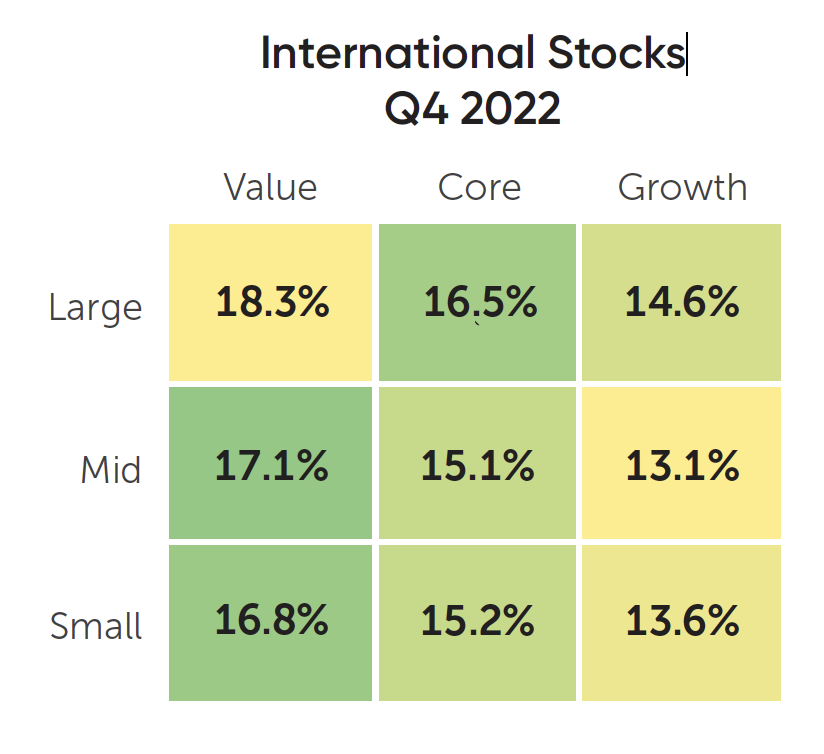FROM OUR INVESTMENT COMMITTEE: Q4 2022 in Perspective
MODERNIST’S ASSET CLASS INVESTING PORTFOLIOS ARE STRATEGICALLY INVESTED WITH A FOCUS ON LONG-TERM PERFORMANCE OBJECTIVES. PORTFOLIO ALLOCATIONS AND INVESTMENTS ARE NOT ADJUSTED IN RESPONSE TO MARKET NEWS OR ECONOMIC EVENTS; HOWEVER, OUR INVESTMENT COMMITTEE EVALUATES AND REPORTS ON MARKET AND ECONOMIC CONDITIONS TO PROVIDE OUR INVESTORS WITH PERSPECTIVE AND TO PUT PORTFOLIO PERFORMANCE IN PROPER CONTEXT.
During the fourth quarter, global stock and bond markets reversed their downward trends from the previous quarter. The S&P 500 Index, a popular headline stock market index in the U.S., increased in October and November before giving back some of the gain in December. Bond markets reversed course with positive returns as inflation readings suggested that inflationary pressures may finally be easing. The result was positive performance for the quarter across all major asset classes.
For the quarter, U.S. stocks (as measured by the Russell 3000 Index) gained 7.2%, and non-U.S. developed market stocks (as measured by the MSCI World Ex U.S. IMI Index) gained 16.0%. Emerging market stocks (as measured by the MSCI Emerging Markets IMI Index) gained 9.5%.
The U.S. Dollar Index, a measure of the value of the U.S. dollar relative to a basket of foreign currencies, decreased during the quarter by 7.7%. Over the past 12 months, the U.S. dollar increased by 8.2%. The increase in the dollar is a headwind to non-U.S. investments held by U.S. investors.
U.S. interest rates increased slightly during the quarter as the Federal Reserve raised the target range of the fed funds rate from 3.00%-3.25% to 4.25%-4.50% with a 0.75% rate hike in November and a 0.50% rate hike in December. Markets are pricing in expectations for another 0.25%-0.75% increase at the Fed’s March meeting.
U.S. Economic Review
The final reading for third quarter annualized GDP growth of 3.2% showed an expansion of economic output, reversing the negative trend of the prior two quarters. The unemployment rate held steady at 3.7% through November. This coincides with a tight labor market; there were approximately 10.5 million job openings for six million unemployed workers at the end of November. Domestic inflation showed a reading of 4.7% in November as the Fed’s preferred gauge of overall inflation, the core Personal Consumption Expenditures (PCE), remained well above the Fed’s long-term target average of 2.0%. Headline inflation, as measured by the Consumer Price Index (CPI), closed out November with a reading of 7.1%. These readings tend to differ primarily because CPI includes volatile categories like food and energy in its methodology while core PCE does not.
Financial Markets Review
Domestically, all size and style equity categories were down during the quarter. International developed stock markets also posted negative performance, and, for U.S. investors, returns were negatively impacted during the quarter by the strengthening U.S. dollar.
U.S. small-cap stocks were the best performing asset class, and U.S. REITs (Real Estate Investment Trust) were the worst performing asset class during the quarter.
The economic uncertainty caused by continuing war in Ukraine, high inflation and the Fed’s ongoing rate-hike campaign caused U.S. and global bonds to lose more than 1% for the quarter and move in the same direction as stocks.
In the U.S., small-cap stocks lagged large-cap stocks in the value and core styles while outpacing large-cap stocks in the growth style. Growth stocks lagged value stocks in all size categories. Among the nine style boxes, large-cap value stocks performed the best, and large-cap growth stocks had the lowest return during the quarter.
Source: Morningstar Direct, January 2023. U.S. markets represented by respective Russell indexes for each category (Large: Russell 1000, Value, and Growth, Mid: Russell Mid Cap, Value, and Growth, Small: Russell 2000, Value, and Growth).
In developed international markets, large-cap stocks outpaced small-cap stocks in all style categories for the quarter. Growth stocks lagged value stocks in all size categories. Among the nine style boxes, international large-cap value stocks performed the best, and international mid-cap growth stocks had the lowest return during the quarter.
A diversified index mix of 60% stocks and 40% bonds would have gained 6.6% during the quarter.
Source: Morningstar Direct, January 2023. International markets represented by respective MSCI World EX USA index series (Large: MSCI World EX USA Large, Value and Growth, Mid: MSCI World Ex USA Mid, Value, and Growth, Small: MSCI World Ex USA Small, Value, and Growth).





